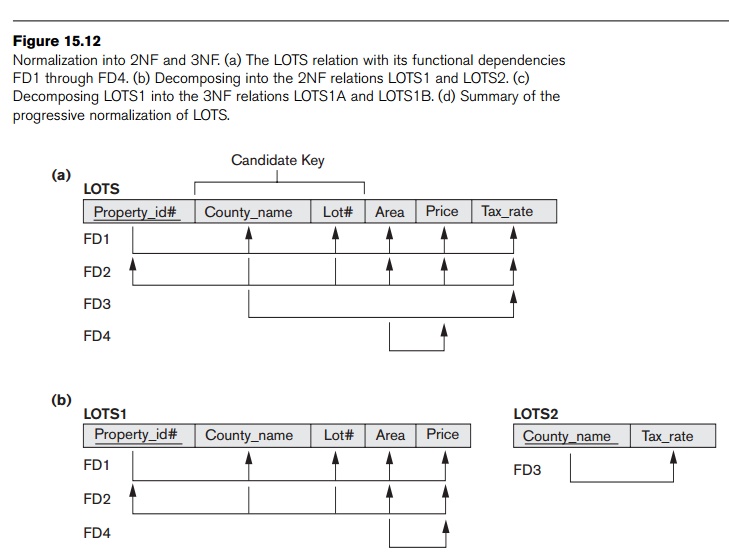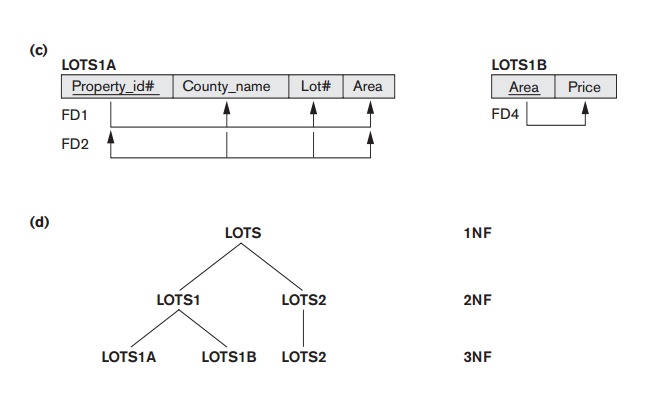Chapter: Fundamentals of Database Systems : Database Design Theory and Normalization : Basics of Functional Dependencies and Normalization for Relational Databases
General Definitions of Second and Third Normal Forms
General Definitions of Second and Third Normal Forms
In general, we want to design our relation schemas so that they have
neither partial nor transitive dependencies because these types of dependencies
cause the update anomalies discussed in Section 15.1.2. The steps for
normalization into 3NF relations that we have discussed so far disallow
partial and transitive dependencies on the primary
key. The normalization procedure described so far is useful for analysis in
practical situations for a given database where primary keys have already been
defined. These definitions, however, do not take other candidate keys of a
relation, if
Table 15.1 Summary of Normal Forms
Based on Primary Keys and Corresponding Normalization

any, into account. In this section we give the more general definitions
of 2NF and 3NF that take all
candidate keys of a relation into account. Notice that this does not affect the
definition of 1NF since it is independent of keys and functional dependencies.
As a general definition of prime
attribute, an attribute that is part of any
candidate key will be considered as
prime. Partial and full functional dependencies and transitive dependencies will now be considered with respect to all candidate keys of a
relation.
1. General Definition
of Second Normal Form
Definition. A relation schema R
is in second normal form (2NF) if
every non-prime attribute A in R is not partially dependent on any key of R.
The test for 2NF involves testing for functional dependencies whose
left-hand side attributes are part of
the primary key. If the primary key contains a single attribute, the test need
not be applied at all. Consider the relation schema LOTS shown in Figure 15.12(a), which describes parcels of land for sale in
various counties of a state. Suppose that there are two candidate keys: Property_id# and {County_name, Lot#}; that is, lot numbers are unique only within each county, but Property_id# numbers are unique across counties for the entire state.
Based on the two candidate keys Property_id# and {County_name, Lot#}, the functional dependencies FD1 and FD2 in Figure 15.12(a) hold. We choose Property_id# as the
primary key, so it is underlined in Figure 15.12(a), but no special
consideration will be given to this key over the other candidate key. Suppose
that the following two additional functional dependencies hold in LOTS:
FD3: County_name → Tax_rate
FD4: Area → Price
In words, the dependency FD3 says
that the tax rate is fixed for a given county (does not vary lot by lot within
the same county), while FD4 says that the price of a lot is
determined by its area regardless of which county it is in. (Assume that this
is the price of the lot for tax purposes.)
The LOTS relation schema violates the general definition of 2NF because Tax_rate is partially dependent on the candidate key {County_name, Lot#}, due to FD3. To nor-malize LOTS into 2NF, we decompose it into
the two relations LOTS1 and LOTS2, shown in Figure 15.12(b). We construct LOTS1 by
removing the attribute Tax_rate that violates 2NF from LOTS and placing it with County_name (the left-hand side of FD3 that causes the partial dependency) into another relation LOTS2. Both
LOTS1 and LOTS2 are in 2NF. Notice that FD4 does not
violate 2NF and is carried over to LOTS1.


2. General Definition
of Third Normal Form
Definition. A relation schema R
is in third normal form (3NF) if,
whenever a nontrivial functional dependency
X → A holds in R, either (a) X is a superkey of R, or (b) A is a prime
attribute of R.
According to this definition, LOTS2 (Figure
15.12(b)) is in 3NF. However, FD4 in LOTS1 violates 3NF because Area is not a superkey and Price is not a prime attribute in LOTS1. To
normalize LOTS1 into 3NF, we decompose it into the relation schemas LOTS1A and
LOTS1B shown in Figure 15.12(c). We
construct
LOTS1A by removing the attribute Price that violates 3NF from LOTS1 and placing it with Area (the left-hand side of FD4 that causes the transitive dependency) into another relation
LOTS1B. Both
LOTS1A and LOTS1B are in
3NF.
Two points are worth noting about this example and the general
definition of 3NF:
■ LOTS1 violates 3NF because Price is transitively dependent on each
of the
candidate keys of LOTS1 via the
nonprime attribute Area.
This general definition can be
applied directly to test whether a
relation schema is in 3NF; it does not
have to go through 2NF first. If we apply the above 3NF definition to LOTS with the dependencies FD1 through FD4, we find that both FD3 and FD4 violate 3NF. Therefore, we could decompose LOTS into
LOTS1A, LOTS1B, and LOTS2 directly. Hence, the transitive and
partial dependencies that violate 3NF can be removed in any order.
3. Interpreting the General Definition of Third Normal Form
A relation schema R violates
the general definition of 3NF if a functional dependency X → A holds in R that does not meet either
condition—meaning that it violates both
conditions (a) and (b) of 3NF. This can occur due to two types of problematic
functional dependencies:
A nonprime attribute determines
another nonprime attribute. Here we typically have a transitive dependency
that violates 3NF.
A proper subset of a key of R functionally determines a nonprime
attribute. Here we have a partial dependency that violates 3NF (and also 2NF).
Therefore, we can state a general
alternative definition of 3NF as follows:
Alternative Definition. A relation schema R is in 3NF if every nonprime attribute of R meets both of the following
conditions:
It is fully functionally
dependent on every key of R.
It is nontransitively dependent on every key of R.
Related Topics